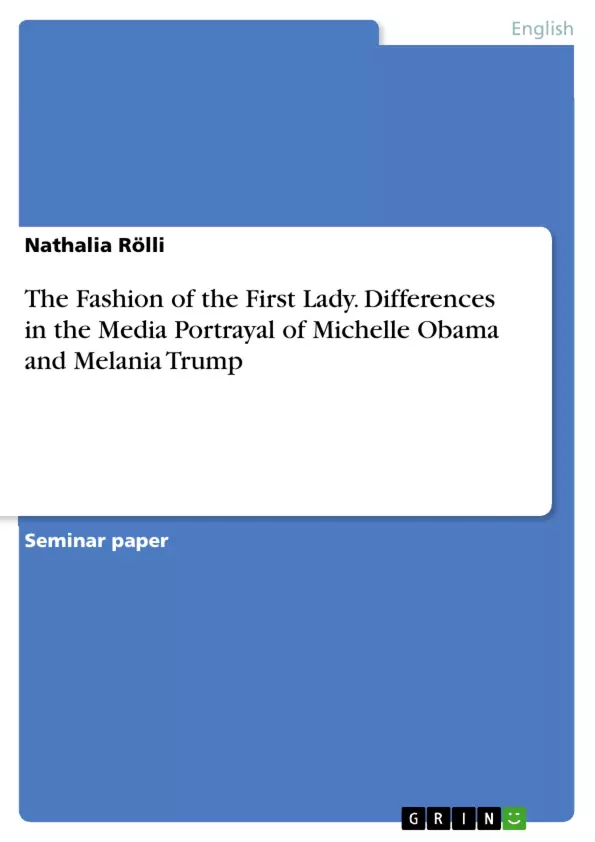This work will focus on the two latest First Ladies, Michelle Obama and Melania Trump. Not only do they give an overview of how republican and democrat First Ladies eventually are depicted differently, but both first Ladies have a special connection to fashion.
The First Lady of the United States, or FLOTUS, is the President's wife's official title. Her position is a job with no rules or descriptions, but she must fulfill duties, including attending events, giving speeches, supporting her husband, and being the mother of a nation. Unlike the President, her job is not a paid one. At first glance, the First Lady paints an outdated picture of wives. As the mother of a nation, the First Lady is supposed to be a role model. Therefore, magazines and news do frequently discuss the image of the President and the First Lady. Those articles often focus on the FLOTUS’ wardrobe, which might signify the wife's perception as an ornament of her husband. They discuss the wardrobe, considering appropriateness and message. FLOTUS studies study what kind of position the First Lady has, but it also studies her position as a role model. To what extent is the First Lady a celebrity, a politician, and a US-citizen, involving information about American culture, politics, and feminism?
Gossip magazines might, at first glance, appear to focus on unnecessary details. However, fashion studies show that clothes have more meaning to them than just protecting the body from the weather. Already in 1950, John Carl Flugel studied the psychology of clothes and discussed the purpose of clothes. Roland Barthes followed Ferdinand de Saussure’s theory on semiology to study fashion magazines and their clothes' portrayal. Alison Lurie extended fashion theory with an actual fashion vocabulary. Theorists like Barthes have described fashion as a sign system, but Lurie specified how clothes talk. Fashion studies explain how clothes create and convey meaning. Furthermore, they ask who the creator of this meaning is and how culture and politics participate in creating meaning through clothes.
Fashion and political studies have been done before and play an essential role in studying the country that wears it. After all, fashion also participates in social change and is even change itself, as Malcolm Barnard analyses. Therefore, the question about the colors and shape of a clothing item is not petty, but essential to understand a country.
Table of Contents
- Introduction
- Fashion Studies
- Function of Clothing
- Fashion as Communication
- Fashion and Identity
- Politics of Fashion
- First Ladies and their Background
- Michelle Obama – Fashionable Lawyer
- Melania Trump - Political Model
- Difference in Portrayal
- Inauguration Gown
- The Gown of the Presidency
- Michelle Obama - A New Beginning
- Melania Trump - A Ray of Hope
- Conclusion
Objectives and Key Themes
This work aims to analyze the fashion choices of two recent First Ladies, Michelle Obama and Melania Trump, and how their styles are portrayed in the media. By examining their backgrounds and the significance of their inaugural ball gowns, the study seeks to understand how fashion can communicate political messages and reflect cultural values.
- The role of fashion in shaping identity and communicating political messages
- Differences in the media portrayal of First Ladies based on their political affiliations
- The symbolic significance of the inaugural gown as a representation of the First Lady's role and the cultural context
- The influence of cultural and religious beliefs on fashion choices and the perception of modesty in American society
- The evolving relationship between fashion and social change
Chapter Summaries
- Introduction: The chapter introduces the concept of the First Lady as a figure with a significant public role, focusing on the importance of her image and fashion choices in shaping public perception. The chapter also provides an overview of fashion studies and its relevance in understanding the political and cultural context of fashion choices.
- Fashion Studies: This chapter explores the various functions of clothing, from its practical purpose of protection to its social, cultural, and economic roles. It discusses the historical development of fashion studies and introduces key theorists like John Carl Flugel, Roland Barthes, and Alison Lurie.
- First Ladies and their Background: This chapter provides detailed biographical information about Michelle Obama and Melania Trump, highlighting their individual backgrounds and their relationship to fashion.
- Inauguration Gown: This chapter delves into the historical significance of the inaugural ball gown as a powerful symbol of the First Lady's role and the cultural context of her presidency. It analyzes the gowns of Michelle Obama and Melania Trump, examining their symbolism, design, and media reception.
Keywords
This work focuses on the key concepts of fashion studies, First Ladies, media portrayal, political communication, cultural symbolism, inaugural ball gown, and the intersection of fashion with social change.
- Quote paper
- Nathalia Rölli (Author), 2020, The Fashion of the First Lady. Differences in the Media Portrayal of Michelle Obama and Melania Trump, Munich, GRIN Verlag, https://www.hausarbeiten.de/document/1363406


